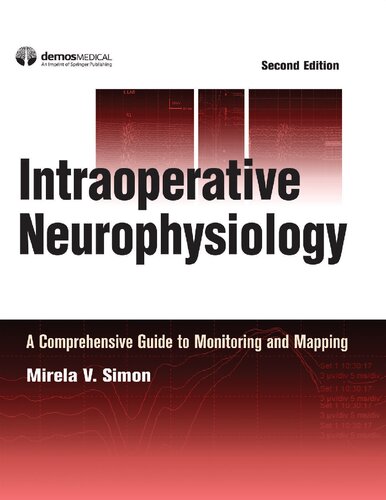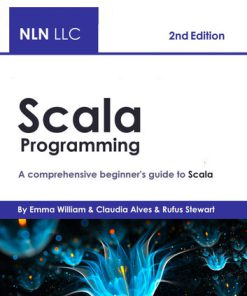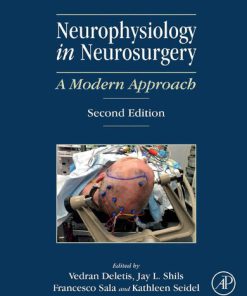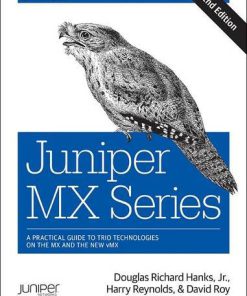Intraoperative Neurophysiology A Comprehensive Guide to Monitoring and Mapping 2nd Edition by Mirela Simon ISBN 9781617052941 1617052949
$50.00 Original price was: $50.00.$25.00Current price is: $25.00.
Intraoperative Neurophysiology A Comprehensive Guide to Monitoring and Mapping 2nd Edition by Mirela Simon – Ebook PDF Instant Download/Delivery: 9781617052941 ,1617052949
Full download Intraoperative Neurophysiology A Comprehensive Guide to Monitoring and Mapping 2nd Edition after payment
Product details:
ISBN 10: 1617052949
ISBN 13: 9781617052941
Author: Mirela Simon
Completely revised and updated second edition of the leading reference on intraoperative neurophysiology, this book covers IOM from the most basic theoretical and technical concepts to the most sophisticated procedures, placing them within the specific surgical context. Written by a multidisciplinary team of experts from Massachusetts General Hospital/Harvard Medical School, Intraoperative Neurophysiology provides a step-by-step approach to monitoring and mapping for a wide variety of complex surgical procedures by progressively building on prior learned material. Covering everything from set-up to troubleshooting and medical management, this book presents an integrated blueprint for choosing the right tests and customizing IOM procedures to the demands of each surgical challenge.
Comprehensive in scope and filled with over 650 helpful illustrations, tables, and neurophysiologic recordings to aid interpretative understanding, this expanded edition includes practical examples of monitoring and mapping and details the importance of an individualized approach to IOM. A highly visual book, it continues to serve as a primary resource for physicians and technologists involved in monitoring to help reduce the operative risk of neurological damage in surgical patients.
New to the Second Edition:
- Extensively broadened coverage of critical topics including mapping procedures brain mapping, and primary neurophysiologic testing in the operating room
- Six entirely new chapters on pediatric neuromonitoring, cerebral aneurysms, electrocorticography, deep brain stimulation, intradural extramedullary tumors, and cardiac procedures
- Enhanced decompressive and deformity correction surgery chapters with added description of surgical steps and mechanisms of injury
- Over 650 high-quality images to enrich and instruct readers
- Appendix with 100 Q&As with detailed rationales that tie back to the chapters
Intraoperative Neurophysiology A Comprehensive Guide to Monitoring and Mapping 2nd Edition Table of contents:
Part I. The Basics
1. Neurophysiologic Tests in the Operating Room
I. Introduction
II. Electroencephalogram
III. Short-Latency Somatosensory Evoked Potentials (SSEPs)
IV. Brainstem Auditory Evoked Potentials
V. Motor Evoked Potentials (MEPs)
VI. Free-Run and Triggered EMG (fEMG and tEMG)
VII. Nerve-to-Nerve Recordings (NAPs)
VIII. Combinations of Tests
IX. Safety Issues
2. Anesthesia and Intraoperative Neurophysiology
I. Introduction
II. General Effects of Anesthetics on Neurophysiologic Tests
III. Anesthetic Agents and Their Specific Effects on Neurophysiologic Tests
IV. Assessing the Depth of Anesthesia
V. The Concept of Anesthetic Fade
VI. Physiological Parameters and Their Impact on Neurophysiologic Tests
Conclusions
3. The Trouble of Troubleshooting
I. Introduction
II. Troubleshooting Electrodes
III. System Settings, Software, and Hardware
IV. 60 Hz and Related Noise
Conclusions
Part II. Cerebrum
4. EEG Monitoring During Carotid Endarterectomy
I. Introduction
II. Surgical Techniques for CEA
III. Principles for Monitoring of Carotid Endarterectomies
IV. Methods
V. Interpretation
5. Neurophysiologic Monitoring During Cardiac and Thoracic Aortic Surgery
I. Introduction
II. Neurologic Complications
III. Cardiopulmonary Bypass (CPB)
IV. Cerebral Neuroprotection
V. Neurophysiologic Monitoring
Conclusions
6. Intraoperative Electrocorticography in Epilepsy Surgery
I. Introduction
II. Historical Perspective
III. The Controversial Role of ECoG in Epilepsy Surgery
IV. Indications
V. Methodology
VI. Interpretation
VII. Anesthesia Considerations
Conclusions
7. Electrocorticography in Nonepilepsy Surgery
I. Introduction
II. Indications
III. Methodology
Conclusions
8. An Introduction to Functional Mapping
I. Maximal Resection
II. Maximal Safe Resection: Functional Mapping Methods
8A. Mapping and Monitoring of Motor and Primary Somatosensory Functions
I. Functional Anatomy
II. Central Sulcus Localization
III. Motor Mapping and Monitoring via Electrical Stimulation
IV. Primary Somatosensory Function Mapping and Monitoring
Conclusions
8B. Mapping and Monitoring of Language and Parietal Functions
I. Introduction
II. Anatomy of Language and Parietal Functions
III. Planning
IV. Methodology
V. Performing the Procedure and Interpreting the Results
Conclusions
8C. Intraoperative Neurophysiologic Monitoring and Mapping of the Visual Pathways
I. Introduction
II. Anatomy of Visual Pathways
III. Monitoring
IV. Mapping the Visual Pathways
V. Anesthesia Considerations
Conclusions
9. Surgical Clipping of Cerebral Aneurysms: General Surgical Approach and the Role of Neuromonitoring
I. Introduction
II. Operative Approach, Critical Steps, and the Role of IOM
III. Assessing the Adequacy of Blood Flow and of Aneurysmal Clipping
Conclusions
10. Deep Brain Stimulation
I. Introduction
II. Methodology: General Approach
III. Subthalamic Nucleus
IV. Globus Pallidus Internus
V. Ventral Intermediate Nucleus of the Thalamus
Conclusions
Part III. Brainstem
11. Neurophysiologic Mapping and Monitoring of Cranial Nerves and Brainstem
I. Introduction
II. Anatomy and Pathophysiology
III. Techniques
IV. Anesthesia Considerations
V. Safety Considerations
VI. Applications
VII. Limitations
VIII. Future Directions
Conclusions
Part IV. Spinal Cord and Nerve Roots
12. Intramedullary Spinal Cord Tumor Resection
I. Introduction
II. The Role of Intraoperative Neurophysiology
III. A Historical Perspective
IV. Intraoperative Neurophysiologic Monitoring and Mapping: A Step-by-Step Approach
Conclusions
13. Intradural Extramedullary Spinal Cord Tumor Resection
I. Introduction
II. IDEM Tumors
III. Intraoperative Neurophysiologic Monitoring of IDEM Tumors
IV. Postoperative Complications and Outcome
Conclusions
14. Decompressive Surgery of the Spine
I. Introduction
II. Intraoperative Neurophysiologic Monitoring: A Step-by-Step Approach
Conclusions
15. Spine Deformity Surgery
I. Introduction
II. Surgical Indications
III. The Nuts and Bolts of Deformity Surgery
IV. The Role of Intraoperative Neurophysiology
V. Intraoperative Neurophysiologic Monitoring: A Step-by-Step Approach
Conclusions
16. Intraoperative Neurophysiologic Monitoring in Thoracoabdominal Aneurysm Repair
I. Introduction
II. The Vascularization of the Spinal Cord
III. Operative Techniques
IV. Delayed Neurological Events and Surgical Outcomes
Conclusions
Part V. Peripheral Nerve
17. Intraoperative Neurophysiology in Peripheral Nerve Surgery
I. Introduction
II. The Main Roles of Intraoperative Neurophysiology
III. Types of Nerve Injury Based on the Extent of Structural Damage and Mechanisms of Occurrence
IV. Surgical Management of Posttraumatic Nerve Injury
V. Nerve Tumor Surgery
VI. Minimally Invasive Surgery
VII. Examples of Common Clinical Scenarios
VIII. Anesthesia Considerations
Conclusions
Part VI. Special Topics
18. Intraoperative Neurophysiologic Monitoring and Mapping in Pediatric Population
I. Introduction
II. Development and Maturation of the Nervous System Pathways
III. Intraoperative Neurophysiologic Monitoring and Mapping Techniques
IV. IONM and Anesthetic Considerations in Pediatric Population
Conclusions
19. Preoperative Functional Mapping for Epilepsy Surgery
I. Introduction
II. Historical Perspective
III. Methodology
IV. Procedure and Results
V. Functional Mapping
VI. Pediatric Functional Mapping
VII. Safety Concerns
Conclusions
20. Questions and Answers
Questions
Answers
Index
People also search for Intraoperative Neurophysiology A Comprehensive Guide to Monitoring and Mapping 2nd Edition:
international society of intraoperative neurophysiology
mirela simon intraoperative neurophysiology
society of intraoperative neurophysiology
remote intraoperative neurophysiology monitoring
Tags:
Mirela Simon,Intraoperative Neurophysiology,Comprehensive
You may also like…
History & Research
A Comprehensive Guide to Music Therapy Stine Lindahl Jacobsen
Computers - PC & Video Games
Computers - Programming
Scala Programming A comprehensive beginner s guide to Scala 2nd Edition Claudia Alves
Education Studies & Teaching
Business & Economics - Management & Leadership
Computers - Networking












